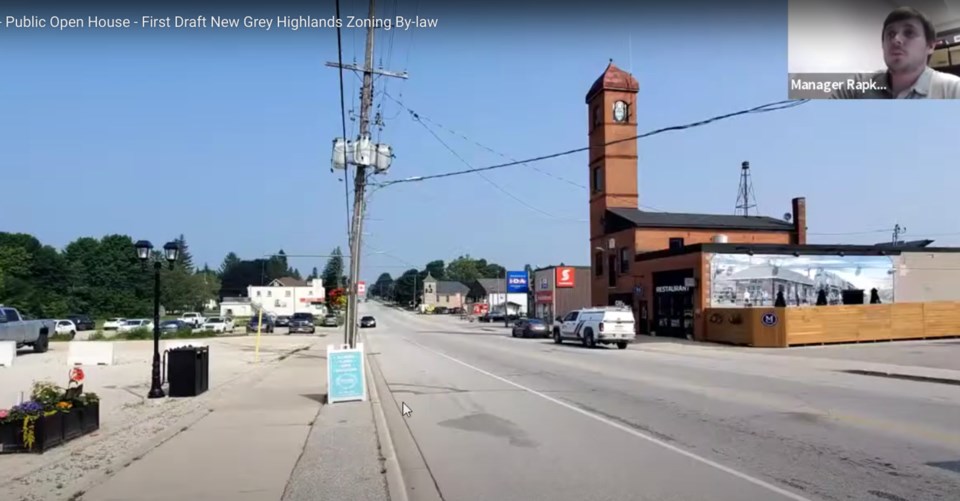The Municipality of Grey Highlands is looking for plenty of public feedback on its work to update its comprehensive zoning bylaw.
Grey Highlands held a virtual public open house on the process to update the bylaw on Sept. 27 in order to gather public comments, concerns and questions about what is being proposed during the update process.
Grey Highlands is in the first phase of a three-phase approach to update its zoning bylaw. The update is necessary to bring the municipality’s zoning regulations into compliance with its official plan, the Grey County official plan and recent provincial planning policy changes.
The current zoning bylaw came into effect in 2006 and is now 17 years old.
“There is a legislative mandate to do this update and there is also a societal need to update the bylaw,” said Matt Rapke, manager of planning. “Things have changed since that time. There are more pressing housing needs now than there were then. There is stuff that should be permitted as of right in the bylaw that is not currently permitted.”
Rapke said the goal of the zoning bylaw update is to create a community that is healthy; safe; productive, adaptable and resilient; inclusive and accessible; beautiful and wealthy.
The municipality is currently involved in the first phase of the update process and is gathering public feedback on the changes being proposed.
“We’re hoping to get lots of feedback from the public to determine topics of interest,” said Rapke.
The municipality set up a dedicated webpage for the project and questions, comments and concerns about the project can be emailed to: [email protected]
The first phase will consolidate public comments and topics of interest for council’s consideration in the near future. The second phase will include the zoning mapping (staff are currently working on the creation of the mapping) for public comment.
The draft bylaw proposes a number of changes to the zoning regulations in Grey Highlands.
The draft bylaw is recommending changes to the number of zones in Grey Highlands. Some would be collapsed into a single zone (for example: a new agriculture zone would include the former zones of: rural residential, rural commercial, agriculture, restricted agriculture and rural). Other zones would expand (for example: the residential zone would be expanded to include: residential full services, residential wastewater service and residential private service).
In addition to the zone changes, the draft also proposes changes to the following: fourplexes as-of-right, additional dwelling units, accessory buildings, home industries as-of-right, home business uses, resource-based recreation, renewable energy, minimum distance separate applicability, holding provisions and parking.
In what would be a significant change, planning staff are recommending the elimination of minimum parking requirements in the zoning bylaw.
In his presentation, Rapke included examples of buildings in Markdale that were limited in size (a second-story apartment could not be added) due to minimum parking requirements.
“It becomes a very large hindrance,” Rapke said of the parking minimums. “And results in hidden societal costs.”
Public comments and concerns at the open house included: the implications of the zoning bylaw update on the Talisman lands in Kimberley, the zoning bylaw update being done before an official plan update, how to encourage more affordable housing through zoning, increasing housing density in rural hamlets and the future of the zone “future development.”
On the Talisman lands:
Rapke said that property currently has a special official plan designation that does allow development. He said the “future development” zone offers the ability to put a “hold” on a property.
“They can’t do anything until they show up later for an amendment,” said Rapke. “That’s what will happen on that property.”
On the zoning bylaw ahead of the official plan:
Rapke said official plan and zoning bylaw updates run in a cycle. The official plan was last updated in 2015-2017, which means they are in the right timeline.
On affordable housing:
Rapke explained that the zoning bylaw is a list of what is not allowed.
“The only thing the zoning bylaw does at the end of the day is prohibit stuff,” he said. “The only thing it can really do is not prohibit certain types of housing in certain places.”
He said provincial policies now permit additional housing units and he said the municipality can assist by eliminating restrictions like parking minimums to encourage more housing.
On housing density in rural hamlets:
Rapke said the biggest barrier to allowing more housing development in rural areas is septic system capacity. He said future studies would have to be conducted to justify an expansion of rural housing capacity or proposals could be considered on a site-specific basis where septic services are adequate and/or not a concern.
On the “future development” zone:
Rapke explained that “future development” was a hold on a property pending a future amendment.
“It’s to avoid permitting something as-of-right that shouldn’t be (permitted),” he said.
Planning staff will now be working to determine topics of interest and will be consolidating public comments received so far. In the near future, their findings will be presented to council for changes to the first draft of the bylaw. Following which, the second draft of the proposed bylaw will be prepared.
